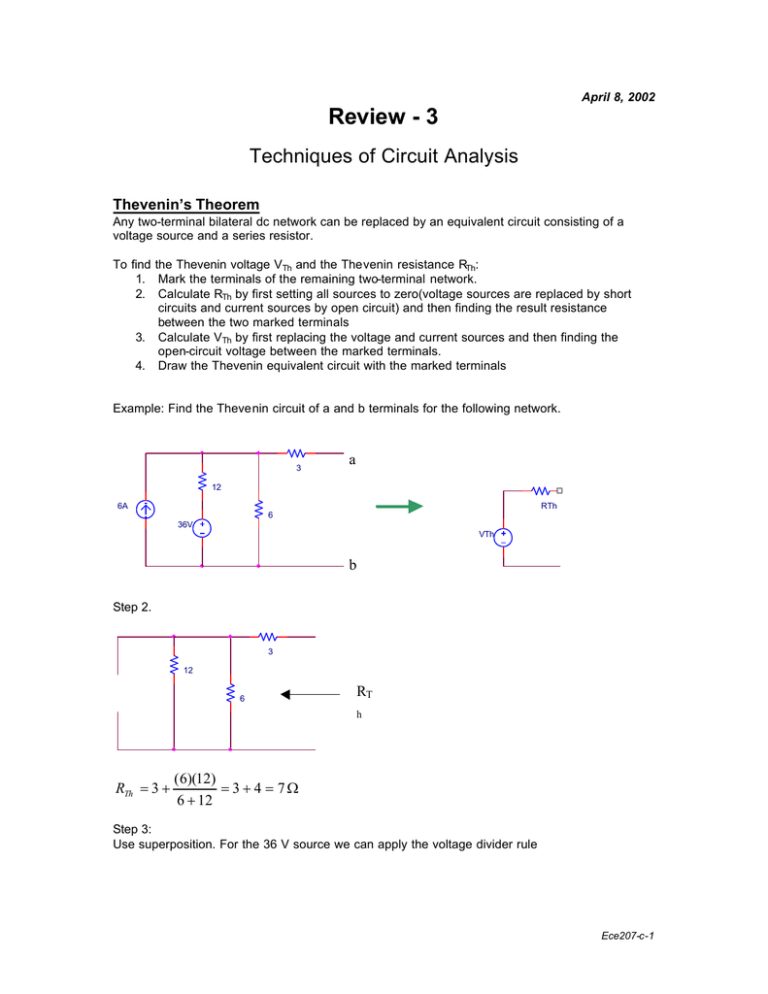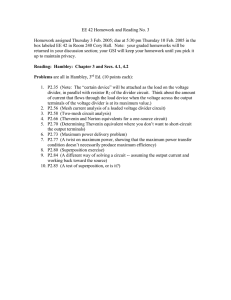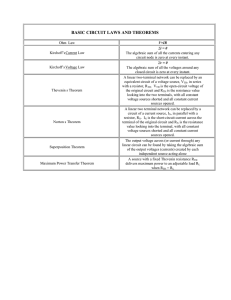Thevenin and Norton equations.
advertisement

April 8, 2002 Review - 3 Techniques of Circuit Analysis Thevenin’s Theorem Any two-terminal bilateral dc network can be replaced by an equivalent circuit consisting of a voltage source and a series resistor. To find the Thevenin voltage VTh and the Thevenin resistance RTh: 1. Mark the terminals of the remaining two-terminal network. 2. Calculate RTh by first setting all sources to zero(voltage sources are replaced by short circuits and current sources by open circuit) and then finding the result resistance between the two marked terminals 3. Calculate VTh by first replacing the voltage and current sources and then finding the open-circuit voltage between the marked terminals. 4. Draw the Thevenin equivalent circuit with the marked terminals Example: Find the Thevenin circuit of a and b terminals for the following network. 3 a 12 6A RTh 6 36V VTh b Step 2. 3 12 6 RT h RTh = 3 + ( 6)(12) = 3 + 4 = 7Ω 6 + 12 Step 3: Use superposition. For the 36 V source we can apply the voltage divider rule Ece207-c-1 3 12 6 36 V ETh' = ( 6)(36) 216 = = 12 V 6 + 12 18 For the 6A source we have can apply the current divider rule 3 12 6A 6 (12)(6) 72 = = 4A 12 + 6 18 = I 6Ω ( 6) = ( 4)( 6) = 24 V I 6Ω = " ETh ' ETh = ETh ETh" = (12)( 24) = 36V Norton’s Theorem Any two-terminal bilateral dc network can be replaced by an equivalent circuit consisting of a current source and a parallel resistor. The steps to find IN and RN 1. Mark the terminals of the remaining two-terminal network. 2. Calculate RTh by first setting all sources to zero(voltage sources are replaced by short circuits and current sources by open circuit) and then finding the result resistance between the two marked terminals 3. Calculate IN by first replacing the voltage and current sources and then finding the shortcircuit current between the marked terminals. 4. Draw the Norton equivalent circuit with the marked terminals Ece207-c-2 Example: Find the Norton equivalent circuit of a and b terminals for the following network. a 4 4 6 7V 2 8A b Step 2: 4 4 6 RN 2 RN = ( 6 / 2)( 4) 12 = = 1.714Ω ( 6 / 2) + 4 7 Step 3: Using superposition for the 7V source IN 4 4 4 6 7V 7V 2 I N' = 7 = 1.75 A 4 For 8A source I 4 4 6 4 2 8A 2 8A Ece207-c-3 I N" = 2(8) = 2.667 A 2+4 I N = I "N − I N' = 2.667 − 1.75 = 0.917 IN RN Maximum Power Transfer RTh VTh RL For maximum Power transfer RTh should be equal to RL RTh = RL The maximum power transfer is p= 2 VTH 4 RL Superposition: • • • Activate one source at a time to calculate the voltage and currents of the circuits ( replacing ideal current sources with an open circuit to deactivate, replacing voltage sources with a short circuit to deactivate) Sum the resulting voltage and currents to determine the voltage and current that exits when all independent sources are active. Depending sources are always active when applying superposition Ece207-c-4



